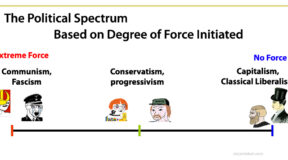
In the “What market failure” we will look at the various claims that the free market failed, and show that the principles of the free market did not fail, but where coercively distorted by government intervention.
Claim: Even with super cheap money from the FED encouraging dubious investments, the banks should of recognized the bad investments them selves. Since the banks did not stop them selves from making bad investments, the free market has failed, and the banks need more regulation.
Banks do make mistakes sometimes. However, the national scale and size of this malinvestment that accrued could of only been accomplished with the help of the government. So why didn’t the banks recognized themselves what poor investments that they were making, and how much risk they were taking on?
In 1936, the Comptroller of the Currency decreed that banks could hold only investment-grade securities. Investment-grade securities carry a triple AAA rating. So banks are required by law to invest only in instruments stamped AAA(investment-grade) by rating agencies. To prevent conflict of interest, and shady outfits from selling triple-A ratings to the highest bidder, the Securities Exchange Commission (SEC) in 1975 designated the ratings of Moody, S&P, and Fitch as the only ones that may be used to satisfy creditworthiness. So we do not have a free market in credit rating agencies. Furthermore, prior to 1975 credit agencies were compensated by the investor, the buyer of the securities, but they began to be compensated by the issuer, the seller. This is an obvious conflict of interest, but now since the agencies were government designated, that meant that they were “trustworthy”. Of-course investors are not prohibited from doing their own credit analysis or paying another firm for its analysis. But why incur the extra cost when the regulators implicitly are endorsing the credit analysis being done by the credit rating agencies. The Big three credit agencies slapped Triple-A on all of the mortgage backed securities that are now classified as toxic assets. Banks invested in these securities thinking they are triple-A, and now they are turning out to be F’s. I suspect that a free-market response to the erroneous credit analysis performed by the Big Three rating agencies will lead to more independent credit analysis on the part of investors going forward. But prior to the recent episode, regulation did not encourage such independent analysis. Had the regulatory-anointed Big Three not slapped “investment-grade” on so much dubious product in this past credit cycle, there would have been less demand for the product. With less demand, there would have been less product originated and fewer credit problems to deal with today.





1 Comment
Dr. doom
(December 2, 2024 - 12:27 am)This article makes several critical errors:
1. Overstates Government Role: It unfairly blames regulations for banks’ reliance on AAA ratings without acknowledging the banks’ voluntary use of flawed models and their own failure to conduct due diligence on underlying assets.
2. Misrepresents Credit Rating Agencies: While the government designated specific agencies, the agencies’ incentive misalignment (being paid by issuers) was a market failure stemming from profit motives, not just regulatory decisions.
3. Neglects Risk-Taking Culture: Banks sought high returns and willingly overlooked risks, suggesting that their behavior was driven by market dynamics, not solely regulatory influence.
4. Ignores Complexity of MBS: The issue wasn’t just ratings; it was the opaque and risky structure of mortgage-backed securities, which financial institutions actively exploited. A free-market approach might have worsened, not solved, the problem.
5. Fails to Propose Practical Solutions: Suggesting less regulation without addressing systemic flaws in the ratings process and risk assessment ignores the lessons of the financial crisis.